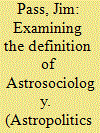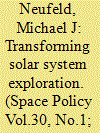| Srl | Item |
| 1 |
ID:
103925


|
|
|
|
|
| Publication |
2011.
|
| Summary/Abstract |
A void has existed within the social sciences for over fifty years since the launch of the first Sputnik satellite in October 1957. This void delineates the boundaries of a missing field, a discipline capable of focusing on the relationship between social life and outer space. It is true that social scientists have pursued space issues over the last thirty years or so. As individuals, they have participated in the areas of search for extraterrestrial intelligence research, astrobiology, space policy, and space history. The strength of astrosociology, however, lies in its formalization of this type of approach into an identifiable field of study, which allows for a more organized and inclusive opportunity for participation. As a starting point, one may express the relationship between social life and outer space as astrosociology. One can define astrosociology as the study of social, cultural, and behavioral patterns related to outer space. The purpose of this article is to provide a general framework for more precise language concerning the definition, scope, character, and future development of astrosociology, while simultaneously attempting to elicit a broader discussion of astrosociology's association to other disciplines. It suggests how the various fields and disciplines associated with astrosociology as a multidisciplinary field can work together to build a missing body of knowledge from their related literatures and contemporary research.
|
|
|
|
|
|
|
|
|
|
|
|
|
|
|
|
| 2 |
ID:
132562


|
|
|
|
|
| Publication |
2014.
|
| Summary/Abstract |
The Discovery Program is a rarity in the history of NASA solar system exploration: a reform program that has survived and continued to be influential. This article examines its emergence between 1989 and 1993, largely as the result of the intervention of two people: Stamatios "Tom" Krimigis of the Johns Hopkins University Applied Physics Laboratory (APL), and Wesley Huntress of NASA, who was Division Director of Solar System Exploration 1990-92 and the Associate Administrator for Space Science 1992-98. Krimigis drew on his leadership experience in the space physics community and his knowledge of its Explorer program to propose that it was possible to create new missions to the inner solar system for a fraction of the existing costs. He continued to push that idea for the next two years, but it took the influence of Huntress at NASA Headquarters to push it on to the agenda. Huntress explicitly decided to use APL to force change on the Jet Propulsion Laboratory and the planetary science community. He succeeded in moving the JPL Mars Pathfinder and APL Near Earth Asteroid Rendezvous (NEAR) mission proposals forward as the opening missions for Discovery. But it took Krimigis's political skill and access to Sen. Barbara Mikulski in 1993 to get the NEAR into the NASA budget, thereby likely ensuring that Discovery would not become another one-mission program
|
|
|
|
|
|
|
|
|
|
|
|
|
|
|
|